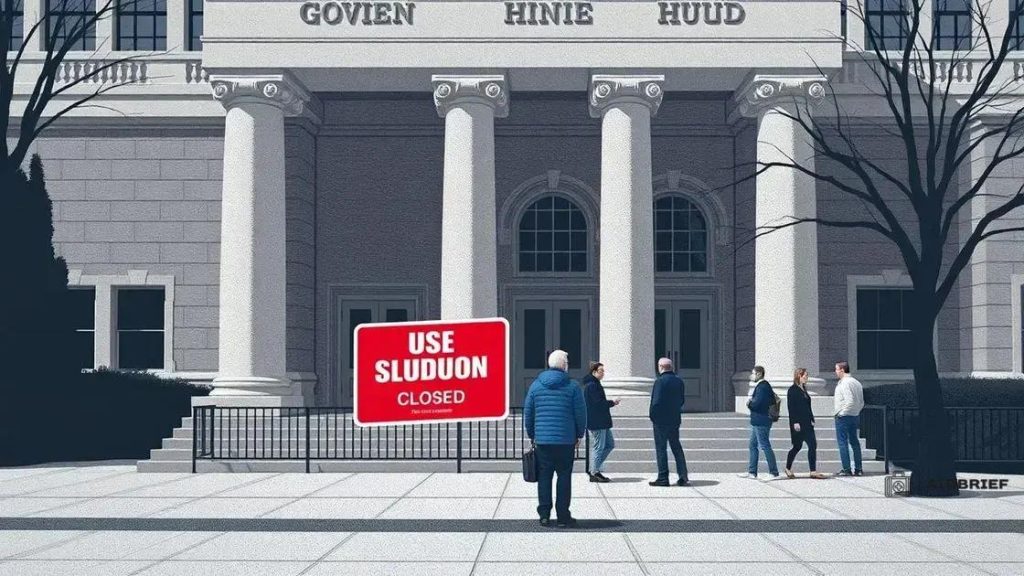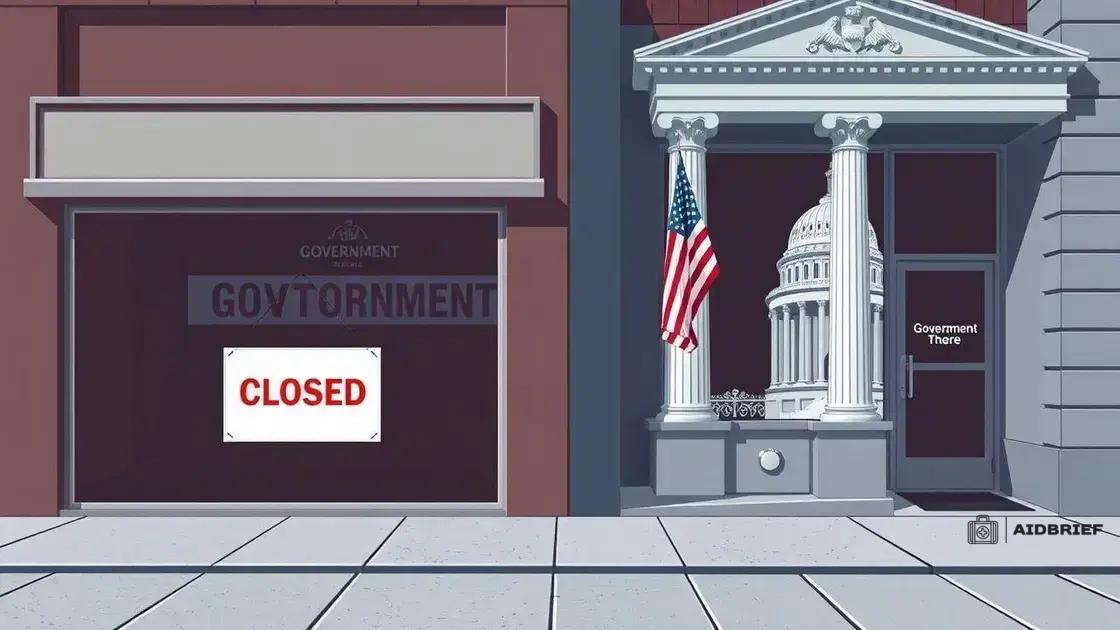Government shutdown news: what you need to know

Government shutdowns significantly impact federal employees and public services, causing furloughs, service disruptions, and economic strain, while prompting public outcry and accountability demands from citizens.
Government shutdown news can feel overwhelming, but understanding its impact helps us navigate the uncertainty. Have you considered how it touches everything from federal services to local businesses? This article sheds light on the essential details you need to stay informed.
Understanding the reasons behind government shutdowns
Understanding the reasons behind government shutdowns is crucial for recognizing their broader implications. These shutdowns occur when there is no agreement on funding the government. A significant factor is often political disagreements between parties.
Key Factors Leading to Shutdowns
Political standoffs are at the heart of most shutdowns. Lawmakers sometimes fail to reach consensus on budgetary issues, leading to a halt in government operations. Key factors include:
- Disagreement on budget allocations: Different priorities can create conflicts between political parties.
- Partisan politics: Tensions between the ruling and opposing parties often escalate into shutdown threats.
- Major policy disagreements: Specific contentious issues can hinder budget negotiations.
Another reason is economic pressures. When the economy struggles, budgets get tighter, leading to more intense negotiations. Unexpected events, such as natural disasters or health emergencies, can also impact funding levels. These situations pressurize lawmakers to make quick decisions, sometimes resulting in a shutdown.
Public perception plays a significant role in the political landscape as well. When the public feels the impacts of a shutdown, pressure mounts on lawmakers to resolve issues quickly. Events like these can shift the tide of negotiations, making quick resolutions urgent.
Effects on Decision-Making
Shutdowns not only disrupt services but also affect the decision-making processes of lawmakers. The urgency to reopen affects policy discussions and often results in last-minute compromises. These compromises can shape future budgets and spending, leading to ongoing conflicts.
Immediate effects on federal employees and services
The immediate effects on federal employees and services during a government shutdown can be significant. Many federal workers are placed on furlough, meaning they cannot work or earn wages. This situation causes stress for these employees and their families as they face uncertainty about their finances.
Impact on Federal Employees
When a shutdown occurs, federal employees may experience a range of impacts:
- Furloughs: Many employees are sent home without pay, affecting their livelihood.
- Work disruptions: Essential federal workers may be required to continue working without pay, leading to frustration and lower morale.
- Delayed benefits: Furloughed workers often face issues with receiving benefits like unemployment insurance.
Furthermore, the absence of federal employees can lead to delays in services. For instance, many government agencies close or scale back operations. As a result, citizens may find it harder to access essential services during this period. This can affect various sectors, such as healthcare, transportation, and social services.
Disruption of Services
Public services often feel the strain when the government shuts down. Here are some areas that face immediate disruptions:
- National parks: Many parks close, limiting access for visitors and affecting local tourism.
- Licensing and permits: Processes for various permits are halted, creating bottlenecks for businesses and individuals.
- Health services: Programs like Medicare and Medicaid may see slower processing times, affecting those reliant on these services.
Ultimately, the impacts stretch beyond federal employees; they reach into communities and everyday lives. Individuals and businesses may find themselves juggling unexpected challenges as they navigate the consequences of a shutdown.
How government shutdowns affect the economy

Understanding how government shutdowns affect the economy is essential for grasping their broader implications. These shutdowns can create immediate disruptions and lead to long-term economic impacts. For instance, when federal workers are furloughed, they stop spending money, impacting local businesses.
Immediate Economic Impacts
During a shutdown, the economy can feel an immediate strain, including:
- Reduced consumer spending: Furloughed employees often cut back on expenses, which can lead to lower sales for local shops.
- Delay in government contracts: Businesses that rely on government contracts may face payment delays, causing cash flow issues.
- Uncertainty in markets: Financial markets may react negatively to a shutdown, increasing volatility.
This economic uncertainty can ripple through various sectors. For example, tourism can take a hit if national parks close, affecting hospitality businesses nearby. Such closures may lead to job losses that extend beyond federal employees and harm local economies.
Long-Term Consequences
The effects of a shutdown can linger long after it ends. Businesses may suffer from lost revenue, and some may even close. Additionally, government programs may face budget cuts once operations resume. This can lead to reduced services in healthcare, education, and infrastructure, affecting millions.
Economic indicators may take time to recover following a shutdown. The uncertainty can lead to spending hesitancy among consumers and businesses alike. For instance, investors might hold off on making significant investments while waiting for stability in government spending and policies.
Ultimately, the cycle of economic impact continues, illustrating how crucial it is for lawmakers to reach agreements promptly. The balance between necessary funding and fiscal responsibility remains a key challenge in maintaining a stable economy.
Public response and government accountability
The public response to government shutdowns plays a crucial role in shaping accountability. Citizens often voice their frustrations through various channels, including social media, protests, and contacting their representatives. This reaction can influence the actions of lawmakers and prompt them to prioritize funding agreements.
Public Outcry
When a shutdown occurs, many individuals express their concerns. Common everyday impacts drive these reactions, including:
- Reduced access to services: Citizens feel the effects of frozen government services, leading to dissatisfaction.
- Job insecurity: Furloughed federal employees worried about their finances often share personal stories.
- Increased visibility of partisan politics: The public can see how political disagreements lead to shutdowns, fostering frustration.
These factors can lead to heightened public awareness and pressure on lawmakers. Citizens demand answers and solutions, using their voting power to hold elected officials accountable. When shutdowns happen repeatedly or last too long, public frustration can morph into political action.
Impacting Government Accountability
The reactions from the public serve as a check on government accountability. Elected officials become more transparent when they feel the weight of public opinion. In many cases, they are pushed to take a stand and negotiate. Citizens expect their leaders to prioritize the needs of the nation over political battles.
Some movements arise advocating for legislative reforms aimed at preventing future shutdowns. Grassroots campaigns and initiatives often promote smarter budgeting practices and encourage bipartisan dialogue to reduce the risks of political stalemates.
Tracking public sentiment during a shutdown can reveal deeper trends in voter behavior. Lawmakers may adjust their strategies based on how the public perceives their response to crisis situations. The ongoing dialogue between citizens and their representatives remains vital for fostering trust and making significant changes.
What to expect during a future shutdown
Preparing for a future government shutdown requires understanding the typical patterns and impacts. While each shutdown can vary, certain expectations often remain consistent. As a shutdown approaches, communication from government officials typically increases, outlining possible consequences for federal employees and public services.
Employee Preparations
Federal employees may start preparing for potential furloughs. Common steps they take include:
- Budget adjustments: Many employees begin to tighten their budgets, anticipating periods without pay.
- Seeking alternative income: Some may look for temporary work or freelance opportunities to cover costs.
- Staying informed: Employees often watch news updates regarding budget negotiations and shutdown likelihoods.
With uncertainty as a constant, workers brace for possible impacts not only on their jobs but also on their ability to pay bills and maintain their lifestyles. Additionally, organizations that depend on federal contracts prepare for disruptions in service delivery.
Impacts on Services
During a future shutdown, citizens can expect notable changes to essential services. Potential impacts include:
- Closure of national parks: Visitors may find parks closed, affecting tourism and local business.
- Slowdowns in processing times: Applications for permits, loans, and other government services may experience delays.
- Healthcare disruptions: Programs like Medicare could see interruptions, affecting many individuals reliant on consistent care.
As these shutdowns unfold, public reaction often intensifies. Citizens may become more vocal about their needs. Social media channels frequently fill with concerns, leading to increased pressure on lawmakers to reach compromises that minimize service interruptions. Ongoing civic engagement during a shutdown can drive accountability and influence future legislative decisions.
FAQ – Government Shutdowns and Their Effects
What typically happens to federal employees during a government shutdown?
Federal employees may be furloughed, meaning they cannot work or earn pay until the shutdown ends.
How do government shutdowns impact public services?
Shutdowns often lead to the closure of national parks, delays in processing permits, and interruptions in healthcare services.
What economic effects can a government shutdown have?
Shutdowns can reduce consumer spending as furloughed workers cut back on expenses, which negatively impacts local businesses.
How does the public respond to government shutdowns?
Citizens often express their frustrations through social media, protests, and contacting their representatives, calling for accountability from their elected officials.





